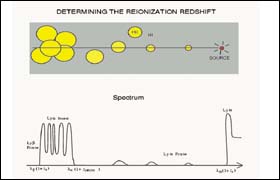Prof. Avi Leib's theory deals with the eras after the Big Bang

The illustration: Courtesy of Prof. Avi Leib and Dr. Renan When were the stars formed in Barkana
In the book "Genesis" it is said: "And God made the two great lights... the great light for the government of the day and the small light for the government of the night and the stars". Generations of scientists have debated the question: when exactly, after the big bang, were the first stars in the universe formed?
An Israeli scientist, the astrophysicist Prof. Avi Leib, currently at Harvard University in the USA, has been working on a theory on this subject for ten years - and only these days has it been confirmed observationally, at the hands of teams of American astronomers.
These conducted a digital mapping of a quarter of the sky, with sophisticated equipment that was used at the observatories in Chile and Hawaii, where the largest ground telescope in the world (10 meters in diameter) is located. This is how the "birth" of the most primordial stars was created: the radiation that was emitted from them and disintegrated the hydrogen atoms in the primordial universe into basic elements: free electrons and protons.
Following this, the series of ages that the primordial universe passed through, from the moment of its birth, was marked:
- The big bang happened 14-12 billion years ago (more precisely: 12.5 billion years).
- The first stars were created 100 million years after the "big bang" and the "birth" of the universe.
- After that the universe sank into a period of "fiery fog" that lasted 900 million years. This period is called the "Dark Age". The hydrogen particles that were dispersed in the "big bang" cooled down and became neutral. The new observations provided evidence for the existence of this "neutral hydrogen".
- After 1 billion years from the "bang", the "cosmic renaissance" began: the era of the initial formation of stars (quasars) and galaxies.
Prof. Leib, in an interview with "Maariv", elaborates: "Only a million years after the 'Big Bang', the following process began: the hot matter that was thrown in all directions in the 'Bang' and spread through space - cooled. When the temperature in the universe dropped below 3000 degrees Kelvin - the electrons and protons merged again into hydrogen atoms, and the universe became transparent.
"The hydrogen was not uniformly distributed in space. There were small disturbances in the density of the material. The disturbances increased over time. Areas of the universe that were denser than suggested were compressed more and more until they collapsed. This is how the first star clusters were formed. Until now, this matter had only theoretical calculations. Now, for the first time, the observations have confirmed them."
Within the first clusters the first stars were formed. They emitted radiation. The radiation broke the primordial hydrogen atoms into light-scattering electrons and free protons. In addition to the stars, massive black holes formed, which absorbed gases into them and also emitted radiation. "With the appearance of these light sources, the process of "re-ionization" began, in which most of the primordial hydrogen atoms were broken into their basic components electron and proton."
Until now, scientists could not see light sources so ancient, so distant - because they were too weak. Observational evidence for the existence of the "Dark Age", and for the period when the hydrogen atoms were broken - was obtained in the study of weak light sources and with the discovery, in April of this year, of a quasar - the most distant light source in the depths of the universe. The quasar was formed when the universe was ten times younger than it is today (about 1.25 billion years ago).
Prof. Leib: "Since the universe is expanding and the distance of light sources from us is faster the farther away the sources are - astronomers measure such distances with the help of the "redshift", caused by the Doppler effect. The greater the redshift, the farther the light source is from us, and the earlier the light emitted from it. The discovered quasar has the largest redshift in its light spectrum, measured so far: "6.3
Prof. Leib, together with his colleague Dr. Renan Barkana (currently in Toronto and in October, a junior professor at Tel Aviv University), completed a detailed review of the Ron brothers' theories and discoveries on this subject, which was published last month in the well-respected journal "Physics Reports". Image: The figure depicts the progress of light (red dot) from a distant source (quasar). The source is surrounded by a mist of neutral hydrogen. The yellow spheres depict regions where the hydrogen atoms were broken into their components, by radiation from a galaxy formed in their center. As light progressed, more galaxies formed and the globular density increased. At this point the primordial fog dissipated.
